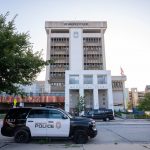Milwaukee’s Best New Building is Invisible
By Raymond Johnson
One of the best new buildings in Milwaukee was completed last month, but you can’t see much of it from the street. In fact, if you go to 1990 N. Commerce St., there doesn’t seem to be a building there at all — just a small urban square with a lookout over the Milwaukee River and a one-store concrete and Plexon tower. Being invisible is just one of many architectural surprises the new Milwaukee Rowing Club (MRC) boathouse, designed by Vetter Denk Architects, has in store.
Vetter Denk has been doing some of the cleanest modern work in the city in recent years. Much of it has been right next door to the MRC on the Beerline ‘B’ Trail in the River Homes project. The boathouse was designed principally by Sebastian Schmalling and Brian Johnson, who have since moved on to start their own firm, JPS Studio, with Adam Pearson.
The building consists of two concrete planes, one at city level and one at river level. Between the two planes, a translucent Plexon façade encloses the boathouse, while sliding wood doors provide access to a staging area to the northeast. The enclosure has a strong horizontal reading that, when combined with the two planes, suggest the movement of sculls in the water, and the river itself flowing through the city. The translucent panels give almost no suggestion to the sculls that lie within. But, from inside, one sees the echoes of the river that once was; the heavy brick factories across the river are presented as in an impressionist painting, their own future ghosts. Inside the space is a raw concrete open room, lit by dappled daylight and a few fluorescent lights.
On top of the city plane, a small urban square was created. It is surrounded by a concrete walkway, which is connected to the sidewalk on the northwest corner and adorned with a simple industrial railing and eight bollard lights. The plane has been planted with grass seed, and one imagines that this will become a sunbathing mecca for city dwellers during the summer months. Hopefully, it will also become something more — perhaps a place where these residents go to protest something? Anything? (Like the lack of parking?) Although it seems a little sparse, this small piece of public space will likely do what all decent urban squares do, bring people together.
Underneath the city plane, the morning sunlight reflects from the water to its underside. Here you are thankful the architects gave you this raw chunk of concrete to reflect the morning light.
Building as Landscape
In addition to its positive formal qualities, the MRC boathouse explores a number of contemporary architectural trajectories. The first is building as landscape. Originally popularized early last century by Wisconsin’s own Frank Lloyd Wright, this idea has been investigated again in recent years. Peter Eisenman’s competition entry for the Musee d’Ethnographie in Paris and Foreign Office Architects’ Yokahama Terminal in Japan are recent examples. In these projects, the architects have tried to merge building and landscape into one, creating a seamless transition that blurs the lines between natural and man-made, exposing the duality for what it is — a sham.
Translucency
The second major theme is translucency. Architects and industrial designers have been exploring translucency in recent years as a post-modern response to the transparency of high modern architecture. The technique involves veiling, or revealing a building slowly, in order to entice users into exploring a building more thoroughly. It is seductive and appeals to the innate human desire to explore mysteries. You’re probably most familiar with Apple Computers, which makes laptops and CPUs that hint at the hardware making them work. Probably less familiar is the amazing Phoenix Central Library, by Milwaukee’s own Will Bruder, which boasts perforated copper “saddlebags” that ethereally expose the service spaces of the building when lit from within at night.
Finally, the planted city plane utilizes a green roof, which have become more common in the last decade thanks to architects looking for ways to reduce energy usage. Green roofs keep buildings cool in the summer by minimizing heat buildup and warmer in winter by providing an additional layer of insulation. According to an August article in the Washington Post, up to 30 percent of new buildings in Europe are going green. Closer to home, Chicago has become a United States leader in green roofs after Mayor Daley saw them in Hamburg, Germany in 1998. Since then, Chicago City Hall now has a green roof, and 48 more green roof urban structures are completed or are in the works.
Young Architects
Overall, the MRC boathouse shows Milwaukeeans what can happen if we trust young designers enough to give them a chance. I’m not sure if you’ve heard, but we have one of the top-ranked departments of architecture in the country right here at UWM. But it has only been around for a few decades so, chances are, your friend’s Dad didn’t go there. Perhaps it’s time to start hiring some of the people who did and find out just what they can do. If the MRC boathouse is any indication, we have a beautiful city just waiting to be built. All we have to do is engage the best and brightest from our own hometown to make it happen.




















